
A water dog is a type of gundog bred to flush and retrieve game from water. Water dogs are considered the progenitors of most modern retriever dog breeds. [1]

A water dog is a type of gundog bred to flush and retrieve game from water. Water dogs are considered the progenitors of most modern retriever dog breeds. [1]

Water dogs are usually medium-sized, active dogs; their most distinctive feature are their tight waterproof coats and their strong desire to swim. Traditionally many long haired water dogs breeds have their coats clipped with a bare midriff and hindquarters to assist in swimming by reducing drag, whilst retaining a long coat around their torso to prevent thermal shock when jumping into freezing water. This classic clip is seen to this day in dog shows with some breeds such as Poodles retaining a variation of this clip. Paintings by artists like Francisco Goya and Albrecht Durer in the 15th century depict early Standard Poodles, which were used for retrieving bird games from water. [2] [3] [4]
Water dogs are an ancient type of dog, used by ancient mariners to retrieve objects lost overboard as well as to pass messages between boats, they were known to the Romans who called them "lion dogs" after the distinctive clipping of their coats. Water dogs continued to be seen aboard ships until modern times. They were known to be prevalent in the Spanish Armada and could still be seen through to the 20th century aboard fishing vessels, particularly in the waters around Spain and Portugal. [3] [4]
In addition to their roles as ships' dogs, in Medieval Europe water dogs were used quite widely by hunters to retrieve ducks from water that had been shot with a bow and arrows, as well as the arrows and bolts that had missed their mark. [3] [4]
With the invention of modern firearms the need for dogs to retrieve arrows disappeared and many of the European water dogs breeds became predominantly ornamental, such as the poodle, whilst others adapted into modern gundogs, like the Wetterhoun. It is believed that water dogs were used, along with other types, in the breeding of most modern retriever breeds. [4]
This is a list of dog breeds usually considered water dogs. [3] [4]
| Breed | Alternate name(s) | Country of origin | Image |
|---|---|---|---|
| American Water Spaniel | American Brown Spaniel & American Brown Water Spaniel |  | |
| Barbet | French Water Dog |  | |
| Cantabrian Water Dog | Perro de agua cantábrico, Perro de lanas & Merlucero |  | |
| English Water Spaniel † | Water Dog & Water Rug |  | |
| Irish Water Spaniel | Whiptail, Shannon Spaniel, Rat Tail Spaniel & Bog Dog |  | |
| Lagotto Romagnolo | Romagna Water Dog & Water Dog of Romagna |  | |
| Poodle | Pudelhund & Caniche |  | |
| Portuguese Water Dog | Cão de Água Português & Cão de Água Algarvio |  | |
| Pudelpointer ‡ |  | ||
| Spanish Water Dog | Perro de agua Español |  | |
| Tweed Water Spaniel † | Tweed Spaniel & Ladykirk Spaniel |  | |
| Wetterhoun | Otterhoun & Dutch Spaniel |  | |
* Often considered a pure retriever
† Extinct breed
‡ Often considered a versatile gundog

The Labrador Retriever or simply Labrador is a British breed of retriever gun dog. It was developed in the United Kingdom from St. John's water dogs imported from the colony of Newfoundland, and was named after the Labrador region of that colony. It is among the most commonly kept dogs in several countries, particularly in the European world.
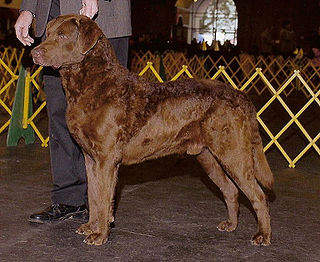
The Chesapeake Bay Retriever is a large breed of dog belonging to the retriever, gundog, and sporting breed groups. The breed was developed in the United States Chesapeake Bay area during the 19th century. Historically used by local market hunters to retrieve waterfowl, pull fishing nets, and rescue fishermen, it is today primarily a family pet and hunting companion, known for a bright and happy disposition; courage; willingness to work; alertness; intelligence; love of water; and hunting capabilities. The Chesapeake is a medium- to large-sized dog similar in appearance to the Labrador Retriever, but with a wavy coat.
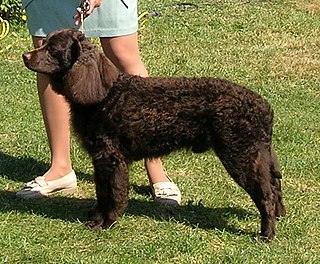
The American Water Spaniel is a breed of spaniel which originated in the United States. It was developed in the state of Wisconsin during the 19th century from a number of other breeds, including the Irish and English Water Spaniels. The breed was saved by Dr. Fred J. Pfeifer, who set up the breed club and standard, and whose work led to recognition for the breed by the United Kennel Club, and later, the American Kennel Club. While they are the state dog of Wisconsin, they remain a rare breed.
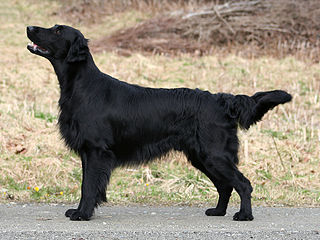
The Flat-coated Retriever is a gun dog breed originating from England. It was developed as a retriever both on land and in the water.

The Goldendoodle, also known as a Groodle, is a designer dog created by crossbreeding a Golden Retriever and a Poodle. First widely bred in the 1990s, they are bred in three different sizes—each corresponding to the size of Poodle used as a parent.

A labradoodle is a crossbreed dog created by crossing a Labrador Retriever and a Standard or Miniature Poodle. Labradoodles were intended to be a good choice for people with canine dander allergies.

The Poodle, called the Pudel in German and the Caniche in French, is a breed of water dog. The breed is divided into four varieties based on size, the Standard Poodle, Medium Poodle, Miniature Poodle and Toy Poodle, although the Medium Poodle is not universally recognised. They have a distinctive thick, curly coat that comes in many colors and patterns, with only solid colors recognized by breed registries. Poodles are active and intelligent, and are particularly able to learn from humans. Poodles tend to live 10–18 years, with smaller varieties tending to live longer than larger ones.

Gun dogs or bird dogs are types of hunting dogs developed to assist hunters in finding and retrieving game. The term hunting dog is broad and includes all breeds and skills of hunting canines, but "gun dogs" refers to canines that are trained to work alongside a loud firearm while hunting or retrieving game. Gun dogs are divided into three main categories: pointers and retrievers, setters and spaniels, and water dogs.
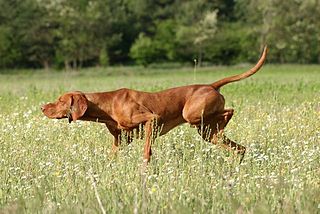
Pointing dogs, sometimes called bird dogs, are a type of gundog typically used in finding game. Gundogs are traditionally divided into three classes: retrievers, flushing dogs, and pointing breeds. The name pointer comes from the dog's instinct to point, by stopping and aiming its muzzle towards game. This demonstrates to the hunter the location of their quarry and allows them to move into gun range. Pointers were selectively bred from dogs who had abundant pointing and backing instinct. They typically start to acquire their hunting instincts at about 2 months of age.

The Portuguese Water Dog originated from the Algarve region of Portugal. From there the breed expanded to all around Portugal's coast, where they were taught to herd fish into fishermen's nets, retrieve lost tackle or broken nets, and act as couriers from ship to ship, or ship to shore. Portuguese Water Dogs rode in fishing trawlers as they worked their way from the Atlantic waters of Portugal to the waters off the coast of Iceland fishing for cod.

The Pointer, sometimes called the English Pointer, is a medium-sized breed of pointing dog developed in England. Pointers are used to find game for hunters, and are considered by gundog enthusiasts to be one of the finest breeds of its type; however, unlike most other hunting breeds, its purpose is to point, not retrieve game.

The coat of the domestic dog refers to the hair that covers its body. Dogs demonstrate a wide range of coat colors, patterns, textures, and lengths.
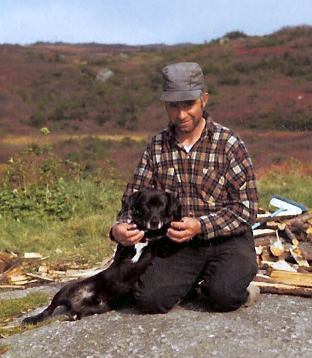
The St. John's water dog, also known as the St. John's dog or the lesser Newfoundland, is an extinct landrace of domestic dog from Newfoundland. Little is known of the types that went into its genetic makeup, although it was probably a random-bred mix of old English, Irish and Portuguese working dogs. They were favourite dogs of fishermen because they had extraordinary qualities like good temperament and working behaviour. The number of St. John's water dogs started declining by the beginning of the 20th century. By the early 1980s, the landrace was extinct.
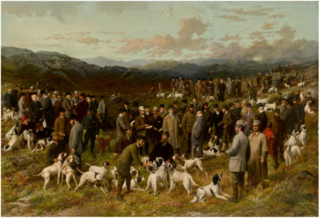
A field trial is a competitive event for gun dogs. Field trials are conducted for pointing dogs and setters, retrievers and spaniels, with each assessing the different types various working traits. In the United States, field trials are also conducted for basset hounds, beagles, and dachshunds.

The Tweed Water Spaniel, or Tweed Spaniel, is a breed of dog extinct since the 19th century. It is best known for being involved in the early development of the modern Curly Coated Retriever and Golden Retriever breeds of dogs. They were described as generally brown, athletic dogs from the area around Berwick-upon-Tweed near the River Tweed and close to the Scottish Borders. A type of water dog, the breed was not well known outside the local area. This breed may have been created by crossing local water dogs with imported St. John's water dog, another breed which is also now extinct.

The Spanish Water Dog breed is used in Spain as a general purpose sheepdog and guard. It is also used sometimes as a gundog, and is skilled at retrieval from water.
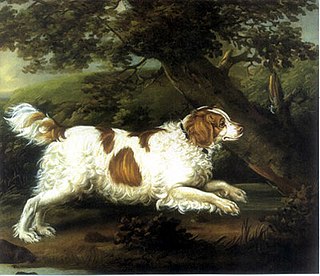
The English Water Spaniel is a breed of dog that has been extinct since the first part of the 20th century, with the last specimen seen in the 1930s. It was best known for its use in hunting waterfowl and for being able to dive as well as a duck. It is described as similar to a Collie or to a cross between a Poodle and a Springer Spaniel with curly fur and typically in a white and liver/tan pattern.

The Golden Retriever is a Scottish breed of retriever dog of medium size. It is characterised by a gentle and affectionate nature and a striking golden coat. It is commonly kept as a pet and is among the most frequently registered breeds in several Western countries. It is a frequent competitor in dog shows and obedience trials; it is also used as a gun dog and may be trained for use as a guide dog.

Sh Ch. Vbos the Kentuckian, also known as Jet, was a Flat-Coated Retriever show dog, bred and handled by Jim Irvine, who won Best in Show at Crufts in 2011 aged 9 years and 7 months, becoming the oldest dog to do so. He was descended from the 1980 Best in Show winner, Ch. Shargleam Blackcap, and placed Best in Show at several other shows around the UK including the Gundog Society of Wales and the National Gundog Association.

The Australian Cobberdog is a purebred dog breed developed in Australia by the Rutland Manor and Tegan Park Labradoodle Breeding & Research Centres. The breed was created as a continuation of Wally Conron's efforts to create a definable and carefully researched labradoodle. This effort was also in response to the increase in demand for labradoodles which had led to breeders referring to any combination of Labrador Retrievers and Poodles as labradoodles without temperament or hypoallergenic criteria. The inconsistency of standards for labradoodles led to the distinction of Australian Labradoodle and the further distinction of Cobberdog attributed to a purebred dog breed with more strict standards for breeding, temperament, and appearance.
{{cite web}}: CS1 maint: multiple names: authors list (link)